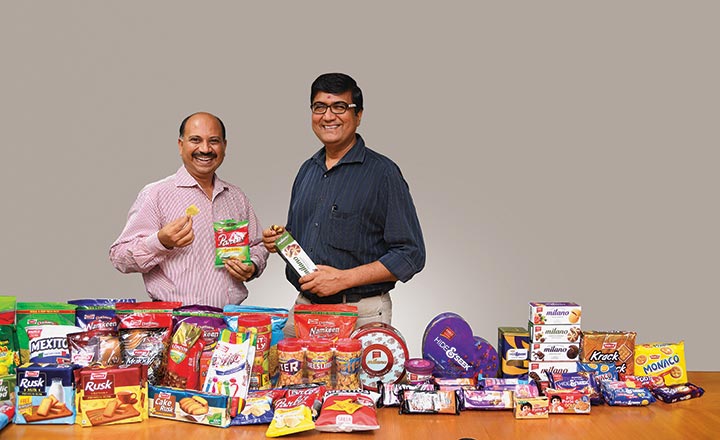For over seven decades, since they started making biscuits in 1938, Parle Products enjoyed a smooth sailing in the Indian market. Their flagship brand, Parle G, holds 20% share of the estimated Rs.25,000-crore biscuit market by value. The yellow striped biscuit pack with the illustrative picture of a young girl is arguably among the most recognised brands in India. Alongside, their brands such as Krackjack, Monaco, 20-20 and Hide & Seek also continued to grow at a robust pace. A strong brand affinity, equity and legacy — Parle Products had it all going their way. Except one thing: perception.
In the past few years, consumer preference saw a sharp switch. With increasing disposable incomes and a young population, consumers were looking for premium offerings, and it seemed like Parle Products was falling short of serving the new and discerning consumer. “Parle (Products) was largely seen as a Parle G company. People didn’t realise that we have a broad range of premium offerings, such as Milano and Hide & Seek, as well as snacks, confectionery, rusk, cakes and chocolates, which consumers liked and consumed. It is just that they didn’t know that it comes from the company that makes Parle G,” says B Krishna Rao, 46, category head (snacks, confectionery), Parle Products, explaining the predicament they found themselves in.
We are seated at a large conference room in Parle Products’ head office in Mumbai. To make his point, Rao gestures towards the glass bowls placed before us on the table. These bowls were filled to the brim with products made at Parle — from the humble Parle G and the premium Hide & Seek to the evergreen Kismi and the new-age Londonderry. And, much like the sultry summer weather, Rao adds that the competitive landscape too has heated up. Peers such as Britannia and ITC had taken up a premium positioning with their offerings while Parle Products was still largely perceived to be a ‘mass’ brand.

It was time to shake off this image and transition from a legacy brand with heritage offerings to a ‘young, nimble company’ that has its ear to the ground. The company took the plunge in 2017. As Mayank Shah, 43, category head (biscuits, chocolates, pulses), Parle Products puts it, “It was now or never.”
Reinventing the legacy
Set up in 1929 by Mohanlal Dayal Chauhan, Parle began its operations from a factory that made confectioneries in Vile Parle, Mumbai. 1938 marked Parle’s foray into biscuits with Parle Gluco (since renamed Parle G). In 1950, 1960 and 1970, Parle was split into Parle Products (led by Vijay, Sharad and Raj Chauhan), Parle Agro (led by Prakash Chauhan and his daughters — Schauna, Alisha and Nadia) and Parle Bisleri (led by Ramesh Chauhan) respectively. The three companies mostly operate in non-competing businesses. The Parle Products office we sit in today, which housed its first factory in the same complex, is seeped in nostalgia. Yet, there is a visible spring in the steps of its employees, almost as if the place has got a dose of youthfulness. Precisely what the company has been trying to do in the past one year.
KV Sridhar, veteran adman, founder and CCO at HyperCollective, observes that while there is a brand affinity for Parle Products even today, “if a legacy brand does not reinvent, it runs the risk of remaining merely as a legacy.” In 2017, Parle Products began its process of reinvention with a three-pronged approach. First was to educate their consumers about the bouquet of brands that Parle Products offers. “Our individual brands are heroes by themselves. But the whole is always greater than the sum of its parts,” says Shah. Accordingly, brands including Krackjack, BakeSmith, 20-20 were advertised under a campaign called Parle — Naam toh suna hoga, launched during the Indian Premier League (Season 10).
Created by Taproot Dentsu, the series of witty ads recreate situations where people are oblivious to certain obvious things in life, just how they are not aware of the multiple brands of Parle. Pallavi Chakravarti, executive creative director, Taproot Dentsu, says the idea was to let the mother brand rub off on bigger brands. “We wanted the communication to be light-hearted and bring a smile on the viewer’s face,” she says. This was followed up with, Naam toh yaad rahega, where Parle Products advertised its confectionery range.
The two-part campaign resulted in ad spends that were 15% higher than usual — upwards of Rs.30 crore for the popular range, and about Rs.20 crore for its new division, Platina. However, both Rao and Shah believe that it has been worth the investment. Apart from consumer awareness, the campaign also helped Parle Products break into the top 10 and jump ranks from 52 to 7 in Brand Equity’s 2018 list of ‘India’s Most Trusted Brands’. More significant was the fact that they ranked higher than their close rival, Britannia, who jumped from rank 24 to rank 8. They also raced ahead of Britannia in TRA Research’s list of ‘India’s Most Attractive Brands’.
The second step was to spin off their premium range under a new division. “We had been thinking about premiumisation for a couple of years. Parle, as a company, stands for certain values that don’t resonate with some of its offerings,” says Shah. As a result, Parle Platina has been spun off as a separate division constituting Hide & Seek, Milano, Simply Good and Mexitos.
Harish Bijoor, brand guru and founder, Harish Bijoor Consults, says, “A company which has grown into a behemoth of more than Rs.10,500 crore in terms of size, faces many challenges. One among them that Parle was facing is that it was seen as an old company with a set of tried and tested products, which the new generation considered jaded. Therefore, the company had to reinvent for a robust future.”
Both Bijoor and Sridhar opine that Parle Products should have made this split much earlier. But with the strong manufacturing, distribution and market understanding, Parle Products has nothing to worry about, they add. The company has over a 100 manufacturing facilities across India and access to about 7 million outlets.
Over the past year, Parle has been focusing on growing its Platina division. The newest offering under it is Milano with hazelnut filling. “This is the first of its kind in the country,” says Shah with a hint of pride, as he steps out to get a sample for us to try. The dual-tone, centre-filled cookie stands as a stark contrast to the pale brown, square-shaped Parle G, highlighting the different consumer bases Parle Products caters to. Both will grow, but the big numbers will come in from Platina, believes Shah. “A lower hanging fruit is moving consumers up the value chain rather than talking about increasing depth of consumption,” he adds.
Pinakiranjan Mishra, partner and national leader, Consumer Products and Retail at Ernst & Young India, says that premiumisation is a strategy adopted by most players in the FMCG market.

In India, biscuits constitute about 72% of the total bakery segment, where cookies has been the largest category, driving double-digit growth over the past few years, accounting for about 50% of the total market in 2016 with a value of Rs.20,209 crore (see: Make way for the cookie). Industry estimates state that while the biscuits segment will grow at a CAGR of 6%, the premium variants such as cream, health biscuits and cookies are expected to grow by 11% between 2017-2023. With rising input costs — sugar, milk and wheat — and lower per capita consumption, there are reduced chances for companies to pass on the price hike to the consumers and protect their margins. Thus, the premium variants are necessary to keep up profitability and drive growth. For instance, due to its focus on premiumisation, Britannia earned a net margin of 9.81% in 2016 (the last fiscal year for which Parle’s full financials are available), while Parle’s net margin stood at 5.3%.
Rao also draws attention to Parle Products’ international business, which contributes 10% of their total revenue. “Parle has a healthy international business with our brands available across the globe in more than 75 countries,” he says. The company also manufactures locally in Cameroon and Nigeria, and is looking at opening a new unit in Mexico.
With a focus on premiumisation, Parle Products’ sales went up by almost 14% (despite a slow growth year due to demonetisation followed by GST). Shah refuses to divulge the revenue numbers, but market estimates peg its turnover to be Rs.10,500 crore for 2017. In FY16, Parle Products earned Rs.9,331 crore in revenue from operations. Platina’s contribution to the overall pie has gone from 15% to 20% within a year. Shah hopes this will hit 30% by the end of the year. There is also a huge opportunity in “our health portfolio” under Simply Good, says Shah, adding that the target now is to double the company’s turnover to Rs.20,000 crore in the next five years.
Mishra, though, sounds a word of caution. “The path to premiumisation needs to be trodden carefully. Premiumisation is only possible up to an extent and only if the products offer real value for the premium sought.
Amnish Aggarwal, senior vice president, research, Prabhudas Lilladher, adds that too much tinkering with a brand could end up being counter-productive. He also says, “Parle Products’ strength has largely been glucose. They have a few brands that are dominating in their respective segments, but they have not seen much success in other categories.”
But Parle seems confident of working around this challenge too. Which brings us to the third part of their strategy change — transitioning from a biscuit maker to a “wholesome food company”.
Slow but steady
While Parle Products has had offerings in confectionery, snacks, cakes, rusk and chocolates for a long time, it is only now that the company is looking at scaling it significantly. Since 2017, the company has been diversifying its product offerings and plugging gaps, and has invested almost 40% more than its annual spends in the process. At present, almost 85% of its present sales come from biscuits. The rest comes from confectionery and snacks. The idea is to innovate and expand these so as to increase their contribution to the overall pie and bring the ratio to 75:25.
Confectionery, as a segment is a distant second to biscuits, but strong in its own right. With around 10 brands, the confectionery segment had a turnover of Rs.1,000 crore for FY17. It grew by 18% in FY18, and Rao expects it to grow by 25% in FY19. Launch of newer variants, as well as the movement of the market towards the Rs.1 price point from 50 paise has contributed to this growth, he believes.
The going is not as good when it comes to snacks, where the biscuit-major has tasted limited success. The company, in 2008, had launched Musst chips, Musst Stix and Monaco Smart Chips. But the products were soon discontinued, as it couldn’t cut ice with the consumer. News reports from 2011 quote several experts blaming the failure on lack of differentiation. Learning from it, Parle re-launched the products in a new avatar in 2011 with Musst Chips, now called Parle Wafers, and Musst Stix, now called Full Toss. The portfolio also includes ‘Chatkeens Namkin’, for which the variants were increased from five to 13 within a year. Mexitos is the premium product under snacks. The category currently contributes only about 3% of Parle Products’ overall revenue. Here too, Rao is hopeful of strong growth.
The company seems to be placing its bets right. Mishra states that the confectionery market in India would continue to grow at a CAGR of approximately 17% during the period 2016-21 and is expected to reach Rs.43,000 crore by 2020. Meanwhile, the savory snacks market in India is expected to clock in a CAGR of over 30% and is expected to reach Rs.141,100 crore by 2020. (GlobalData — Confectionery: Market snapshot to 2021).
North and West are Parle’s strongest markets for their confectionery and snacks segments. To ensure minimal errors in its newer offerings, the company relies on a slow and steady approach. For instance, the biscuit maker has had a presence in rusks and cakes since 2014. “Only after having a sustainable presence for several years in the east zone, we started spreading cakes nationally. Rusk, as a portfolio, is also shaping up. From elaichi rusk, we have expanded the line to include milk rusk, garlic bread toast, and in November, we launched cake rusk,” says Rao.
Yet another big announcement from Parle Products was its foray into pulses in 2017. Shah smiles as he gives the example of an Indian thali. “Look at the Indian thali. Everything is branded, from wheat flour, rice to oil, salt, sugar. Except pulses. There are just one or two national players in this space.” He continues enthusiastically to highlight the huge opportunity that lies untapped. “We are talking about a potential of almost Rs.1.5 lakh crore worth of market per year. In terms of volume, it is 28-30 million tonne per annum,” he says. The company launched their staples brand, Fresh Harvest, in Maharashtra and Karnataka, but adds that it will be a slow expansion because the consumption varies from region to region.
What the company hasn’t changed much is its chocolates business. An important but small part of Parle Product’s portfolio, Freiburg is retailed at high-end stores at prices that are at par or higher than imported chocolates. Then there is also a tie-up that the company has entered into with Manpasand Beverages. “It is not for the short-term, but it is just a business collaboration, don’t read too much into it please,” exclaims Shah before we quiz him about their interest in foraying into beverages.
For now, the immediate focus is on consolidating the new businesses before foraying into other segments. Yes, the market is cluttered, but for a company that has been around for close to 90 years, that surely is not a concern. They are cognisant of competition but not deterred by it. As we near the end of the meeting, Rao points out a simple goal they are working towards. “In the next 2-3 years, we want to be seen as the top food brand in the country,” Going by the pace at which Parle Products is making progress, that seems to be an easy target to hit.












 Just one email a week
Just one email a week